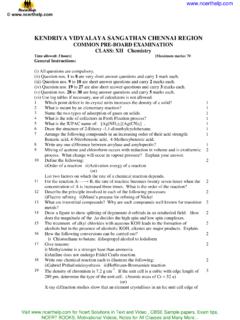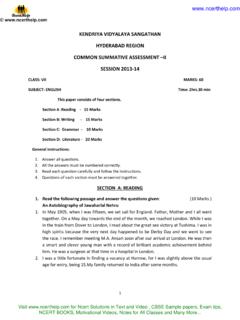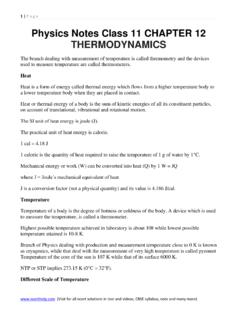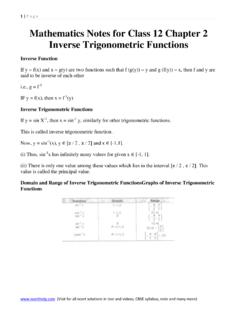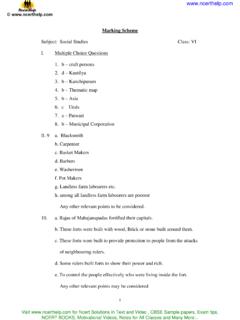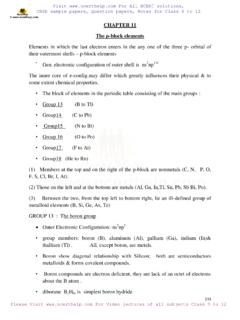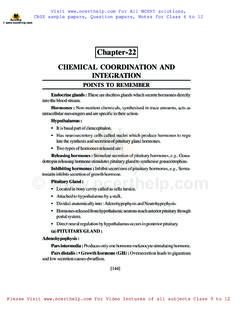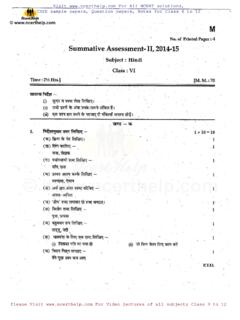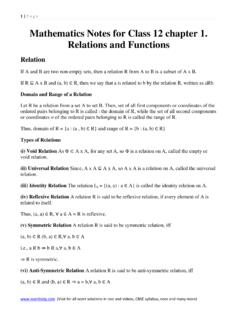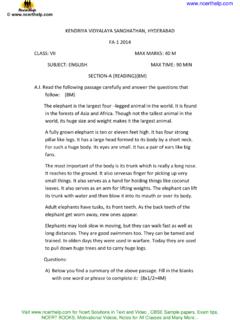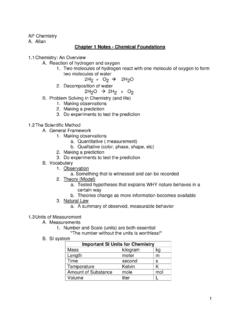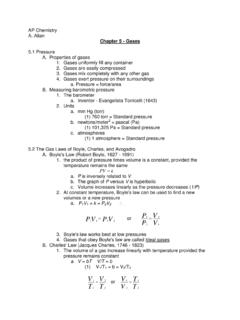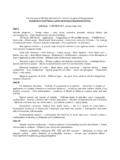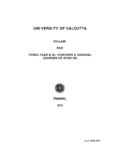Transcription of Chemistry Notes for class 12 Chapter 1 The Solid State
1 1 | P a g e (Visit for all ncert solutions in text and videos, CBSE syllabus, note and many more) Chemistry Notes for class 12 Chapter 1 The Solid State Solids Solids are the chemical substances which are characterised by define shape and volume, rigidity, high density, low compressibility. The constituent particles (atoms, molecules or ions) are closely packed and held together by strong interparticle forces Types of Solids The solids are of two types : Crystalline solids and amorphous solids. Distinction Between Crystalline and Amorphous Solids Crystalline Solid Amorphous solids 1 These have definite and regular arrangement of the constituent particles in space. These doesn t have any regular arrangement of the constituent particles in space.
2 2 These are true solids. Theseare super cooled liquids or pseudo soilds. 3 These have long order arrangement of the particles. These have short order arrangement of particle. 4 These are anisotropic in nature, , their physical properties are different in different directions. These are isotropic in nature , their physical properties are same in all the directions. 5 They have sharp melting points. They melt over a certain range of temperature. 6 They undergo a clean cleavage when cut. They undergo irregular cleavage when cut. 2 | P a g e (Visit for all ncert solutions in text and videos, CBSE syllabus, note and many more) Structure Determination by X-ray Diffraction (Bragg s Equation) When a beam of X-rays falls on a crystal plane composed of regularly arranged atoms or ions, the X-rays are diffracted.
3 If the waves are in phase after reflection, the difference in distance travelled by the two rays , path difference) must be equal to an integral number of Wavelength, n for constructive. Thus, path difference = WY + YZ = XY sin + xy sin 3 | P a g e (Visit for all ncert solutions in text and videos, CBSE syllabus, note and many more) = 2 XY sin = 2d sin n = 2d sin This equation is called Bragg s equation. Where, n = 1. 2, (diffraction order) = wavelength of X rays incident on crystal d = distance between atomic planes = angle at which interference occurs. Unit Cell The smallest geometrical portion of the crystal lattice which can be used as repetitive unit to build up the whole crystal is called unit cell.
4 Types of Unit Cell (i) Simple or primitive Unit cell In which the particles are present at the corners only. (ii) Face centred unit cell In which the particles are present at the corners as well as at the centre of each of six faces (iii) Body centred unit cell In which the particles are present at the corners as well as at the centre of the unit cell. 4 | P a g e (Visit for all ncert solutions in text and videos, CBSE syllabus, note and many more) (iv) End centred unit cell In which the particles are present at the corners and at the centre of two opposite faces. Number of Particles Per Unit Cell Seven Crystal Systems There are about 230 crystal forms, which have been grouped into 14 types of space lattices, called Bravais Lattices, on the basis of their symmetry and seven different crystal systems on the basis of interfacial angles and axes.
5 Seven Crystal Systems 5 | P a g e (Visit for all ncert solutions in text and videos, CBSE syllabus, note and many more) Packing Fraction It is defined as the ratio of the volume of the unit cell that is occupied by the spheres to the volume of the unit cell. (i) Primitive cubic unit cell Atoms touch each other along edges. Hence, d = a or r = a / 2 (r = radius of atom and a = edge length) Therefore, PF = 4 / 3 r3 / (2r)3 = or (ii) Face centred cubic unit cell Atoms touch each other along the face diagonal. Hence, d = a / 2 or r = 2a / 4 Therefore; PF = 4 * 4 / 3 r3 / (4r / 2)r3 = or 74% (iii) Body centred cubic unit cell Atoms touch each other along the body diagonal. Hence, 3a / 2 or r = 3a / 4 Therefore; PF = 2 * 4 / 3 r3 / (4r / 3)r3 = or 68% Coordination Number 6 | P a g e (Visit for all ncert solutions in text and videos, CBSE syllabus, note and many more) It is defined as the number of particles immediately adjacent to each particle in the crystal lattice.
6 [In simple cubic lattice, CN is 6, in body centred lattice, CN is 8 and in face centred cubic lattice, CN is 12]. High pressure increases CN and high temperature decreases the CN. Close Packing in Crystals Two Dimensional Packing of Constituent Particles (i) Square close packing Space occupied by spheres is (ii) Hexagonal close packing Space occupied by spheres is It is more efficient. Three Dimensional Packing of Constituent Particles (i) ABAB arrangement gives hexagonal close packing (hcp). (ii) ABCABC arrangement gives cubic close packing or face centred CUbIC packing (ccp or fcc). In both these arrangements 740/0 space is occupied Coordination number in hop and ccp arrangement is 12 while in bcc arrangement, it is 8.
7 Close packing of atoms in cubic structure = fcc > bcc > sc. All noble gases have ccp structure except He (hcp structure). Void or Space or Holes 7 | P a g e (Visit for all ncert solutions in text and videos, CBSE syllabus, note and many more) Empty or vacant space present bet veen spheres of a unit cell, is called void or space or hole or interstitial void. When particles are closed packed resulting in either cpp or hcp structure, two types of voids are generated: Tetrahedral voids are holes or voids surrounded by four spheres Present at the corner of a tetrahedron. Coordination number of a tetrahedral void is 4. Octahedral voids are holes surrounded by six spheres located on a regular tetrahedron.
8 Coordination number of octahedral void is 6. [The number of octahedral voids present in a lattice is equal to the number of close packed particles. The number of tetrahedral voids present in a lattice is twice to the number of close packed particles.] Density of Unit Cell (d) Density of unit ce11 = mass of unit cell / volume of unit cell d = Z * M / a3 = ZM / a3 * NA (The density of the unit cell is same as the density of the substance.) where, d = density of unit cell 8 | P a g e (Visit for all ncert solutions in text and videos, CBSE syllabus, note and many more) M = molecular weight Z = no. of atoms per unit cell NA = Avogadro number a = edge length of unit cell. The Structure of Ionic Crystals The ionic radius ratios of cation and anion, play a very important role in giving a clue to the nature of the crystal structure of ionic substances.
9 Radius Ratio and Crystal Structure Ionic crystals may be of two types (i)AB type and (ii) A2B or AB2 Structure of Ionic Crystals 9 | P a g e (Visit for all ncert solutions in text and videos, CBSE syllabus, note and many more) On applying pressure NaC} structure (6 : 6 coordination) changes into CsCI structure (8 : 8 coordination) and reverse of this occur at high temperature (760 K). Imperfections in Solids In a crystalline Solid , the atoms, ions and molecules are arranged in a Definite repeating pattern, but some defects may occur in the pattern. derivations from perfect arrangement may occur due to rapid cooling or presence of additional particles. The defects are of two types, namely point defects and line defects.
10 Point Defects Point defects are the irregularities or deviations from ideal arrangement around a point or an atom in a crystalline substance Point defects can be classified into three types : (1) psychometric defects (2) impurity defects (3) non stoichiometric defects 1. Stoichiometric Defect These are point defects that do not disturb the -stoichiometric of the Solid . They are also called intrinsic or thermodynamic defects. In ionic solids, basically these are of two types, Frankel defect and Schottky defect 10 | P a g e (Visit for all ncert solutions in text and videos, CBSE syllabus, note and many more) AgBr has both Schottky and Frenkel defects. Frenkel defects are not found in pure alkali metal halides because cations are of large size.
